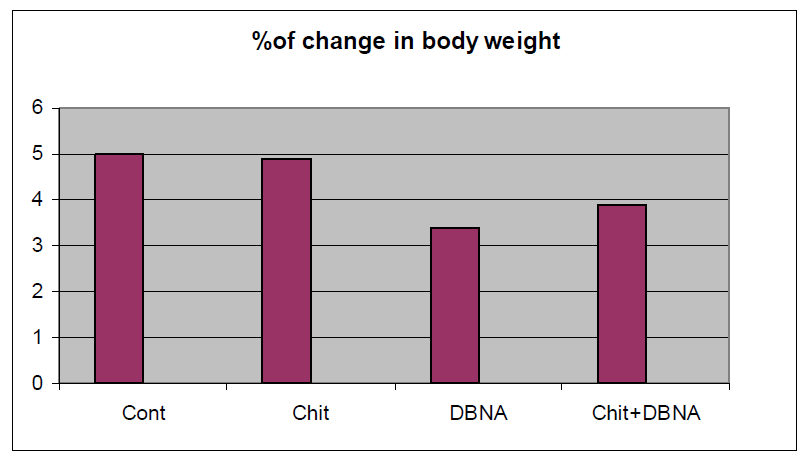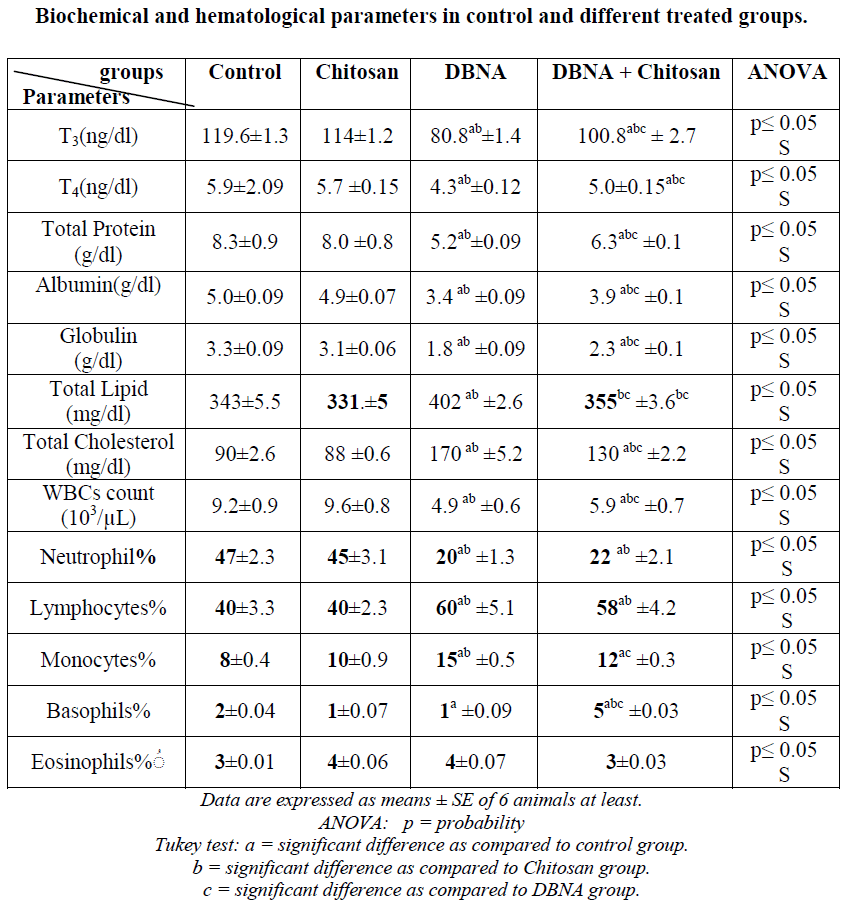Research Article - (2011) Volume 1, Issue 4
Zoology Department, Faculty of Science, Mansoura University, Mansoura, R.A.E.
The present work was to elucidate the effectiveness of orally administered chitosan-Cu complex (200 mg/kg b.wt.) as a prophylactic agent against some harmful disturbances in mice orally treated freshly prepared dibutylnitrozamine (DBNA) (NaNO2 + DBA, 2000 ppm & 1000 ppm respectively) for 12 weeks. DBNA resulted in dramatic decrease in T3 and T4 levels, accompanied by decline in serum total protein, albumin and globulin concentration. In addition total leukocytes and neutrophils remarkably decline, parallel with exceed in lymphocytes and serum total lipid. Also, the total body weight negatively affected. However, most of these noteworthy effects of DBNA were suppressed by chitosan-Cu complex pretreatment indicating its protective role against various metabolic alterations caused by DBNA.
Chitosan, DBNA, Thyroxin, Metabolism.
Nitrosamine is found in many food stuffs especially beer, fish byproducts and in meat and cheese products preserved with nitrite picking salts; they can be also formed by frying or smoking [Khan and Malhotra 2011], in addition to rubber workers, breathing asbestos or exposure to radiation, Straif et al [2000].
Toxicological effect of nitrosamines include hepatotoxicity growth retardation, impairment of reproductive functions and endocrine disturbances, Proksch [2001].
The wide environmental distribution of nitrites and secondary amines has been show to result in an increased risk of endogenous formation of N-nitroso compounds, Choi et al [2002].
The administration of 4-hydroxybutylnitrosamine to male mice yielded a high incidence of large palpable urinary bladder cancer, Lubet et al [2005].
Chitosan is the most important derivative of chitin which is the structural element of the exoskeleton of crustaceans, [Sanjiv et al 2011]. Chitosan, the linear polymer of d-glucosamine in β-(1-4) linkage has been recommended as a suitable functional material because of its biocompatibility, biodegradability, non-toxicity, adsorption properties and regulation cell activation, Pae et al [2001] and Yoon et al [2005]. Due to its antimicrobial activity chitosan have many pharmaceutical application and generally used as natural preservative for the safety of food [Sharma et al 2010] and [kalyan et al 2010].
Chitosan was reported by Yan et al [2006] to inhibit malondialdehyde formation and hence reduce lipid perxidation.
The purpose of this study was to investigate the effectiveness of chitosan-Cu complex on some metabolic abonormalities caused by DBNA in male mice.
Thirty, four weeks old male mice were purchased from eye-bank in Giza, Egypt, they were adapted for one week at the air conditioned animal house at Mansoura University, fed a chow diet for rodent. Food and drinking water were available ad libitum for 6 weeks. The animals were maintained in accordance with the guidelines for the care and use of the laboratory. They are classified into 4 groups, (a) control group(n=6), (b) DBNA treated group (n=8) (NaNO2 2000 + DBA 1000 ppm respectively) in drinking water for 6 weeks. (c) chitosan-Cu complex orally treated group (n=8) (200 mg/kg) orally for 6 weeks. (d) Chitosan-Cu complex followed by DBNA treatment (n=8), by the same route and time as in groups (c) and (b) respectively. Chitosan-Cu complex Mwt=9000Da, deacetylation 62% was prepared in physics Dept., Faculty of Science Mansoura University, through fund from research box in Mansoura University. Body weight in each group was recorded every week for calculation of body weight changes.
Blood samples were collected in heparinized tubes for estimation of WBCs and detection of differential count in a blood smear stained with lishman's stain [Brown, 1973].
Other blood samples were collected in nonheparinized tubes, left to clots allowed to centrifuge where sera were collected for determination of T3, T4 using 125I, radio-immune assay [Larsen, 1981], total protein (Cannon & Henry 1974),total lipids [Fring et al 1972].
Statistical analysis: All data were expressed as mean ± SE. The data analysis was performed by ANOVA test, Tukey test, a P value of <0.05 was considered significant. The comparison was carried out with control or with DBNA treated data.
As shown in the figure and the table, DBNA treatment results in a significant decline in most estimated parameters especially T3 level (-35%) except for the increase in total lipids, total cholesterol, lymphocytic and monocytic counts. Administration of chitosan-Cu complex nearly did not appearantly affect the estimated parameters. Chitosan-Cu complex treatment pre DBNA administration nearly rended the estimated parameters towards normal values.
With increment detection and internally synthesis of nitrosamine in foods it is of importance to study how to protect peoples effectively from it. Chitosan and its derivatives have received most attention and are currently used in many fields. Low molecular weight chistosan is especially important medicine foods, cosmetics and agriculture because of the special physiological activity such as antitumor, antifungal, enhancing immunity, lowering cholesterol levels, water retention [Singh & Rary 2000]. The present work showed a reduction in T3 and T4 level in DBNA treated mice, these reduction can be explained by the reduced amino acids levels due to liver damage by DBNA, Anthoney et al [1994],endocrine disorders [Proksch, 2001] and/or enzymes needed for thyroxin synthesis or libration from thyroglobin, a point which need further investigation. The suggested ameliorative role of chitosan may be through ameliorating the hypothalamic pituitary axis which regulates the secretion of TRH, Edrees et al [1995].
Regarding leukocytes, a decrease were showed in its number after DBNA administration which may be due to the fatal blood disorders methemoglobinemia, a views which in accordance with Terblanche, [1995]. The data obtained revealed that DBNA showed a remarkable decrease in the counts of neutrophils , this is belived to be due to depression of haematopoietic function, where Lijinsky & Reuber [1984] found that nitrosamine and nitrosomethylanine given to rats induced depression in hepatopoitic properties.
The production of reactive oxygen species by neutrophils predominantly comes from the activation of NADPH oxidase to generate O2¯ , Clark et al [1990], and Kadri-Hassani et al [1995].
As neutrophils produce reactive oxygen species (ROS) which contribute to the brain pathogenesis and signal the inflammatory response, Liou et al [2003].
A recovery of leucopenia was noted with chitosan-Cu complex treatment pre DBNA that may be attributed to the role of chitosan in protecting bone marrow with its antioxidant properties, Jeon et al [2001].
Obtained decline in serum total protein and that of albumin in DBNA treated animals may be due to the destruction of liver architecture and necrosis caused by DBNA Mclean et al [1965]. In addition, the inability of hepatic cell to synthesis protein must be taken into consideration as reported by El-Nagar [2006].Protein synthesis may be also blocked through the inactivation and degradation of the isoenzyme CYP2EI [Vittozzi and Nastainczyk, 1987].
Regarding amelioration in body weight in chitosan –Cu complex treatment pre DBNA administration, it seems that chitosan interact with cell membrane enhancing peptide and protein uptake, Poropratto et al [2005].
The effect of chitosan-Cu complex in normalization of serum protein level , in agreement with Serag et al [2009] and may be through the antioxidant property leading to free radical scavenging activity by the effect of H2O2 in breakdown of chitosan at the weak points to get low molecular weight chitosan that possess good O2¯ scaveging activity because its geometry (square-planar), favours reaction of O2¯ reacting with Cu2+ giving normal liver function and hence protein synthesis, Yin et al [2004]. The attenuation caused by chitosan-Cu complex may be also due to its capability in exerting significant cytoprotection in necrotic damage induced by DBNA, Jeon et al [2003].
The obtained hyperlipidamia in DBNA treated mice are in agreement with Beaupre and Schiffman [1994] and may be attributed to protein loss in urine that decrease plasma osmotic pressure enhacing hepatic synthesis of lipoprotein causing a secondary hyperlipipedemia., a view which in agreement with Samuels et al [2002].


The improvement caused in mice administered chitosan-Cu complex pre DBNA treatment agree with Yao and Chiang [2002] and may be explained by inhibition of diatery fat digestion Kanauchi et al [1995] and/or decrease of plasma VLDLc and LDLc which increase HDLc level as reported by Chiang et al [2000]. The antilipidimic property of chitosan through regulating total cholesterol reported by Xeng et al [2008] must be taken into consideration.
The ability of chitosan in reducing lipid absorption in the intestine by binding with fatty acids and bile acids and increasing their excretion may also lead to this hypolipidemic effect, Chee et al [2005].
This study suggested that chitosan-Cu complex with low molecular weight possess good O2¯ scavenging activity and improve protein and lipid metabolism as well as thyroid abnormalities.